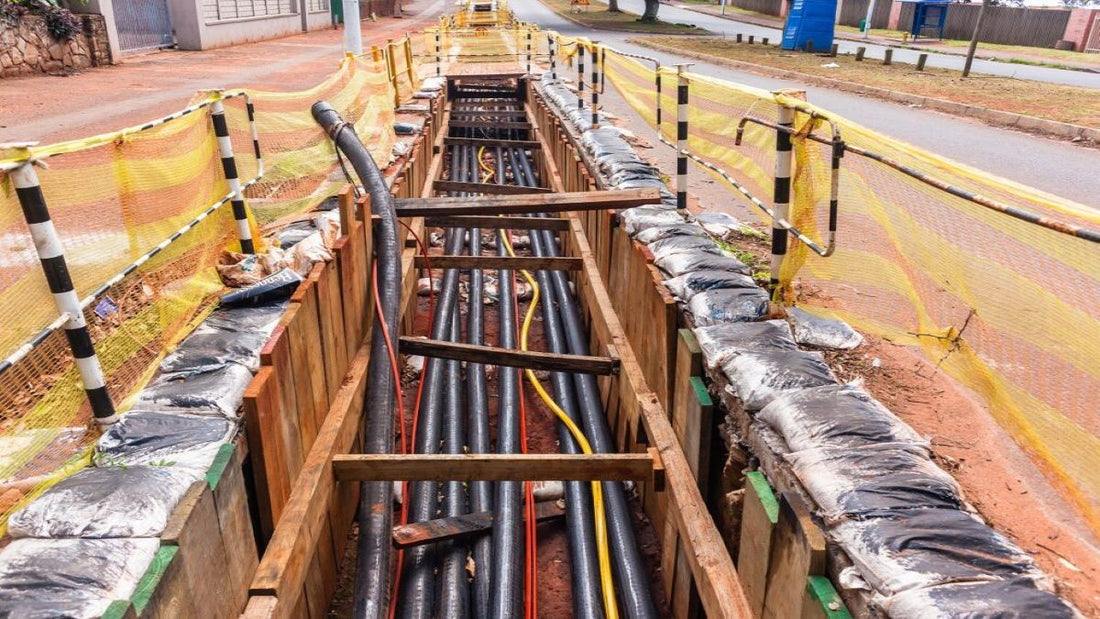
The Comprehensive Guide to Trenching
Share
When it comes to construction and landscaping, trenching is a fundamental technique that can make or break your project. Whether you’re laying pipes, installing cables, or creating drainage systems, understanding the ins and outs of trenching is crucial. Let’s dig into the details of trenching and see why it’s so essential.
What is Trenching?
Trenching involves creating narrow, deep excavations in the ground. These trenches are often used for installing underground utilities, such as electrical lines, water pipes, and gas lines. Trenching ensures these utilities are protected and efficiently routed.

The History of Trenching
Ancient Trenching Methods
Early civilizations used rudimentary tools for trenching. Ancient Romans, for instance, created extensive trench systems to manage water and sewage.
Modern Trenching Evolution
Today, trenching has evolved significantly with advanced machinery and techniques. Trenchers, which are specialized machines, have revolutionized the way we dig and lay utilities.
Types of Trenching
Manual Trenching
Manual trenching is done using shovels and pickaxes. It’s labor-intensive but ideal for small-scale projects where precision is key.
Mechanical Trenching
Mechanical trenching utilizes heavy machinery like trenchers. These machines can quickly and efficiently dig trenches of various sizes, making them perfect for large-scale projects.
Key Tools for Trenching
Trenchers
Trenchers come in various sizes, from small walk-behind models to large, ride-on machines. They are designed to cut through soil and rock with ease.
Shovels and Spades
For detailed and precise work, traditional shovels and spades are indispensable. They allow for manual adjustments and fine-tuning of trench dimensions.
Safety Measures in Trenching
Protective Gear
Wearing the right protective gear, including hard hats, gloves, and safety boots, is essential to prevent injuries.
Shoring and Shielding
To prevent trench collapses, shoring and shielding techniques are employed. These methods support trench walls, ensuring a safe working environment.
The Impact of Soil Types on Trenching
Clay Soil
Clay soil can be challenging to trench due to its density and stickiness. It requires more effort and the right equipment to manage.
Sandy Soil
Sandy soil is easier to work with but poses a higher risk of collapsing. Proper shoring is critical in these conditions.
Rocky Soil
Rocky soil demands heavy-duty equipment and more time to trench. Specialized trenchers with rock-cutting capabilities are often used.
Lifcon: Your Trusted Partner in Trenching Solutions
Lifcon is a premier online platform specializing in the marketing, supplying, and selling of trenching equipment. They offer a comprehensive range of tools and machines designed to meet the needs of both DIY enthusiasts and professionals. With Lifcon, you can tackle any trenching project with confidence.
Why Choose Lifcon?
Extensive Product Range
Lifcon boasts an extensive selection of trenching tools and equipment, ensuring you find the perfect match for your project.
Quality and Durability
All products from Lifcon undergo strict quality checks to ensure they meet industry standards and provide long-lasting performance.
Expert Support
Lifcon’s team of experts is always ready to assist you with any questions, helping you choose the right tools and offering tips for efficient trenching.
Trenching Techniques: Best Practices
Planning Your Trench
Before you start digging, plan your trench carefully. Mark the area and determine the depth and width needed for your project.
Digging Efficiently
Use a combination of manual and mechanical trenching techniques to achieve the best results. For large trenches, start with a trencher and finish with manual tools for precision.
Post-Trenching Cleanup
Once your trench is complete, clean up the site. Remove excess soil and debris, and ensure the trench is properly covered or marked for safety.
Future Trends in Trenching
Automated Trenching
Automation is the future of trenching. Automated trenchers equipped with GPS and sensors can dig precise trenches with minimal human intervention.
Eco-Friendly Trenching
Sustainable trenching practices are gaining traction. Using energy-efficient equipment and minimizing soil disruption are key focuses for the industry.
In summary, trenching is an essential skill in construction and landscaping. With the right knowledge and tools, you can tackle any trenching project efficiently. Lifcon provides top-notch trenching equipment and expert support, making your trenching endeavors a breeze.

